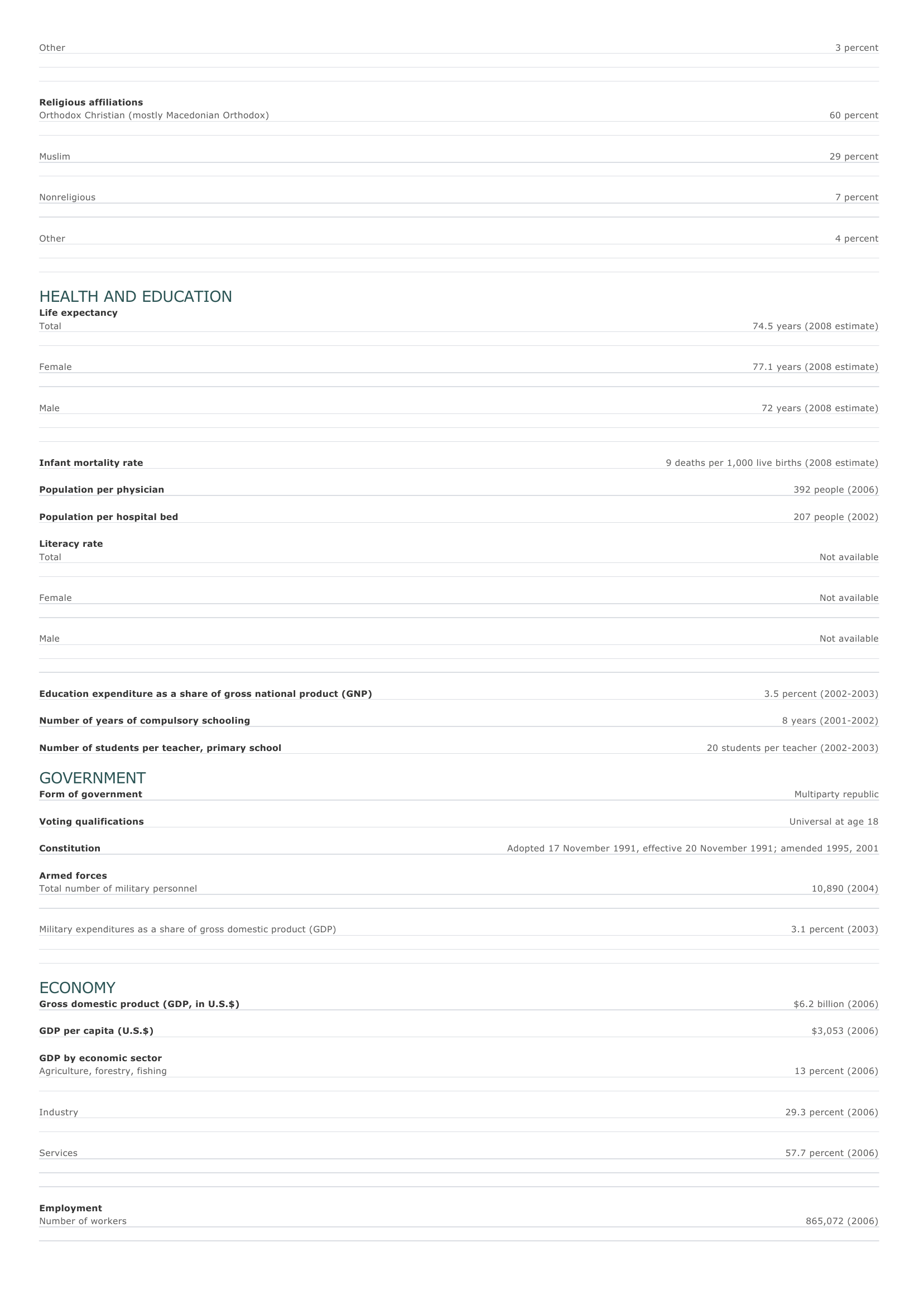F.Y.R.O. Macedonia Facts and Figures. BASIC FACTS Official name The Former Yugoslav Republic of Macedonia Capital Area Skopje 25,713 sq km 9,928 sq mi PEOPLE Population Population growth Population growth rate 2,061,315 (2008 estimate) 0.26 percent (2008 estimate) Projected population in 2025 2,119,511 (2025 estimate) Projected population in 2050 1,990,728 (2050 estimate) Population density 83 persons per sq km (2008 estimate) 215 persons per sq mi (2008 estimate) Urban/rural distribution Share urban 60 percent (2005 estimate) Share rural 40 percent (2005 estimate) Largest cities, with population Skopje 515,419 (2004 estimate) K umanovo 105,484 (2004 estimate) Bitola 95,385 (2004 estimate) Tetovo 86,580 (2004 estimate) Prilep 76,768 (2004 estimate) Ethnic groups Macedonian Slavs 67 percent Albanian 23 percent Turkish 4 percent Serbian 2 percent Roma (Gypsy), other 4 percent Languages Macedonian 70 percent Albanian 21 percent Turkish 3 percent Serbo-Croatian 3 percent O ther 3 percent Religious affiliations Orthodox Christian (mostly Macedonian Orthodox) 60 percent Muslim 29 percent Nonreligious 7 percent O ther 4 percent HEALTH AND EDUCATION Life expectancy Total 74.5 years (2008 estimate) Female 77.1 years (2008 estimate) Male Infant mortality rate 72 years (2008 estimate) 9 deaths per 1,000 live births (2008 estimate) Population per physician 392 people (2006) Population per hospital bed 207 people (2002) Literacy rate Total Not available Female Not available Male Not available Education expenditure as a share of gross national product (GNP) Number of years of compulsory schooling Number of students per teacher, primary school 3.5 percent (2002-2003) 8 years (2001-2002) 20 students per teacher (2002-2003) GOVERNMENT Form of government Multiparty republic Voting qualifications Universal at age 18 Constitution Armed forces Total number of military personnel Military expenditures as a share of gross domestic product (GDP) Adopted 17 November 1991, effective 20 November 1991; amended 1995, 2001 10,890 (2004) 3.1 percent (2003) ECONOMY Gross domestic product (GDP, in U.S.$) GDP per capita (U.S.$) GDP by economic sector Agriculture, forestry, fishing $6.2 billion (2006) $3,053 (2006) 13 percent (2006) I ndustry 29.3 percent (2006) Services 57.7 percent (2006) Employment Number of workers 865,072 (2006) Workforce share of economic sector Agriculture, forestry, fishing 20 percent (2005) I ndustry 32 percent (2005) Services 48 percent (2005) Unemployment rate 37.2 percent (2004) National budget (U.S.$) Total revenue Not available Total expenditure Not available Monetary unit 1 denar, consisting of 100 deni Major trade partners for exports Germany, Greece, United States, Italy, and Croatia Major trade partners for imports Germany, Greece, Serbia, Russia, and Slovenia ENERGY, COMMUNICATIONS, AND TRANSPORTATION Electricity production Electricity from thermal sources 83.74 percent (2003 estimate) Electricity from hydroelectric sources 16.26 percent (2003 estimate) Electricity from nuclear sources 0 percent (2003 estimate) Electricity from geothermal, solar, and wind sources 0 percent (2003 estimate) Number of radios per 1,000 people 206 (1997) Number of telephones per 1,000 people 262 (2005) Number of televisions per 1,000 people 280 (2000 estimate) Number of Internet hosts per 10,000 people 17 (2003) Daily newspaper circulation per 1,000 people 19 (1996) Number of motor vehicles per 1,000 people Paved road as a share of total roads 151 (1997) 64 percent (1999) SOURCES Basic Facts and People sections Area data are from the statistical bureaus of individual countries. Population, population growth rate, and population projections are from the United States Census Bureau, International Programs Center, International Data Base (IDB) (www.census.gov). Urban and rural population data are from the Food and Agriculture Organization (FAO) of the United Nations (UN), FAOSTAT database (www.fao.org). Largest cities population data and political divisions data are from the statistical bureaus of individual countries. Ethnic divisions and religion data are largely from the latest Central Intelligence Agency (CIA) World Factbook and from various country censuses and reports. Language data are largely from the Ethnologue, Languages of the World, Summer Institute of Linguistics International (www.sil.org). Health and Education section Life expectancy and infant mortality data are from the United States Census Bureau, International Programs Center, International database (IDB) (www.census.gov). Population per physician and population per hospital bed data are from the World Health Organization (WHO) (www.who.int). Education data are from the United Nations Educational, Scientific and Cultural Organization (UNESCO) database (www.unesco.org). Government section Government, independence, legislature, constitution, highest court, and voting qualifications data are largely from various government Web sites, the latest Europa World Yearbook, and the latest Central Intelligence Agency (CIA) World Factbook. The armed forces data is from Military Balance. Economy section Gross domestic product (GDP), GDP per capita, GDP by economic sectors, employment, and national budget data are from the World Bank database (www.worldbank.org). Monetary unit, agriculture, mining, manufacturing, exports, imports, and major trade partner information is from the statistical bureaus of individual countries, latest Europa World Yearbook, and various United Nations and International Monetary Fund (IMF) publications. Energy, Communication, and Transportation section Electricity information is from the Energy Information Administration (EIA) database (www.eia.doe.gov). Radio, telephone, television, and newspaper information is from the United Nations Educational, Scientific and Cultural Organization (UNESCO) database (www.unesco.org). Internet hosts, motor vehicles, and road data are from the World Bank database (www.worldbank.org). Note Figures may not total 100 percent due to rounding. Microsoft ® Encarta ® 2009. © 1993-2008 Microsoft Corporation. All rights reserved.












